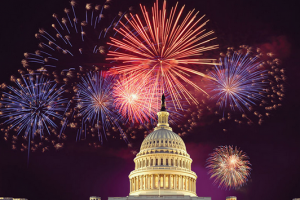At the outbreak of fighting in April 1775, few colonists wanted complete independence from Great Britain. Those who did were thought to be radical. By the middle of the following year, however, sentiments had shifted and many more colonists now favored independence.
Then, in August 1775, a royal proclamation from Great Britain declared that the King’s American subjects were “engaged in open and avowed rebellion.”
Later that year, Parliament passed the American Prohibitory Act, which made all American vessels and cargoes forfeit to the Crown.
And in May 1776, the Congress learned that the King had negotiated treaties with German states to hire mercenaries to fight in America.
The weight of these actions combined to convince many Americans that the mother country was treating the colonies as a foreign entity.
Thomas Paine’s bestselling pamphlet “Common Sense,” published in early 1776, fueled the growing hostility of the colonists against Britain and helped spread American revolutionary sentiments.
In June 7, 1776, the Continental Congress met at the Pennsylvania State House (later called Independence Hall) in Philadelphia. The Virginia delegate Richard Henry Lee introduced a motion calling for the colonies’ independence.
Amid heated debate, Congress postponed the vote on Lee’s resolution, but appointed a five-man committee that included Thomas Jefferson of Virginia, John Adams of Massachusetts, Roger Sherman of Connecticut, Benjamin Franklin of Pennsylvania and Robert R. Livingston of New York. They were charged to draft a formal statement justifying the break with Great Britain.
American Independence Birthday – July 4th
Years later, reflecting on those times, Thomas Jefferson wrote, in 1823, that the other members of the committee “unanimously pressed on myself alone to undertake the draught [sic]. I consented; I drew it; but before I reported it to the committee I communicated it separately to Dr. Franklin and Mr. Adams, requesting their corrections. . . I then wrote a fair copy, reported it to the committee, and from them, unaltered to the Congress.”
Jefferson’s account reflects three stages in the life of the Declaration of Independence:
- the document originally written by Jefferson;
- the changes to that document made by Franklin and Adams, resulting in the version that was submitted by the Committee of Five to the Congress; and
- the version that was eventually adopted.
On July 2nd, the Continental Congress voted in favor of Lee’s resolution for independence in a near-unanimous vote (the New York delegation abstained, but later voted affirmatively).
On that same day, after the vote, John Adams wrote to his wife Abigail that July 2 “will be celebrated, by succeeding generations, as the great anniversary Festival” and that the celebration should include “Pomp and Parade…Games, Sports, Guns, Bells, Bonfires and Illuminations from one End of this Continent to the other.”
Two days later, on July 4th, the Congress formally adopted the Declaration of Independence, which had been written largely by Jefferson. Though the vote for actual independence took place on July 2nd, formal adoption of the Declaration took place two days later, and thus the 4th became the day celebrated as the birth of American independence.
Celebrating the 4th of July
In the Pre-Revolutionary years, colonists had held annual celebrations of the king’s birthday, which traditionally included ringing of bells, bonfires, processions and speech-making.
During the summer of 1776 some colonists celebrated the birth of independence by holding mock funerals for King George III, as a way of symbolizing the end of the monarchy’s hold on America and the triumph of liberty. But more commonly, from this summer forward, July 4th festivities included concerts, bonfires, parades and the firing of cannons and muskets, usually accompanied the first public readings of the Declaration of Independence.
Philadelphia held the first annual commemoration of independence on July 4, 1777, while Congress was still occupied with the ongoing war. George Washington issued double rations of rum to all his soldiers to mark the anniversary of independence in 1778, and in 1781, several months before a key American victory at Yorktown, the state of Massachusetts became the first to make July 4th an official state holiday.
In 1778, across the Atlantic Ocean, Ambassadors John Adams and Benjamin Franklin held a dinner for their fellow Americans in Paris, France.
After the Revolutionary War, Americans continued to commemorate Independence Day every year, in celebrations that allowed the new nation’s emerging political leaders to address citizens and create a feeling of unity.
By the last decade of the 18th century, two major political parties—the “Federalists” and the “Democratic-Republicans”— had formed. Each held separate Independence Day celebrations in many of the large cities.
July 4th Becomes A National Holiday
The tradition of patriotic celebration became even more widespread after the War of 1812, in which the United States again faced Great Britain.
In 1870, the U.S. Congress made July 4th an unpaid holiday for federal workers.
In 1941, the provision was expanded to grant a paid holiday to all federal employees. Over the years, the political importance of the holiday would decline, but Independence Day remained an important national holiday and a symbol of patriotism.
In a remarkable coincidence, both John Adams and Thomas Jefferson, the only signers of the Declaration of Independence later to serve as Presidents of the United States, died on the same day: July 4, 1826, which was the 50th anniversary of the Declaration.
Although not a signer of the Declaration of Independence, James Monroe, the Fifth President of the United States, also died on July 4, several years later, in 1831.
Calvin Coolidge, the 30th U.S. President, was born on July 4, 1872, and thus the only President to be born on Independence Day.
RELATED RESOURCES:
- Common Sense, by Thomas Paine
- Declaration of Independence – read it for yourself, absolutely inspiring!
- President Trump’s talk at Mount Rushmore Fourth of July celebration (President’s talk begins at 37:42)
———————-
Mike Breen is a retired, brilliant marketer to Fortune 500 companies, the founder and provocateur of Parallel Thinking, and the author of “Constitutional Cuisine” (pending publication).


